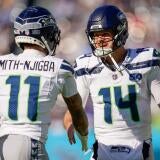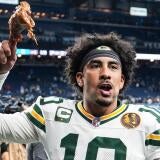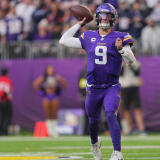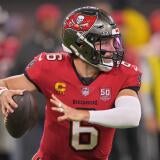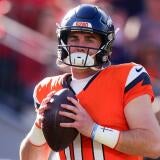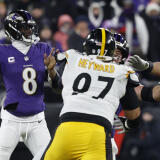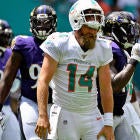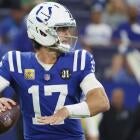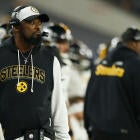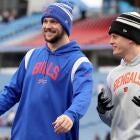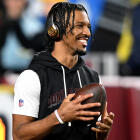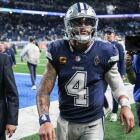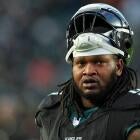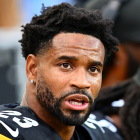Dolphins are tanking, but recent history suggests that winning and playoffs may still be years off
A stockpile of draft picks is no guarantee to fix all that's broken in Miami
The Dolphins have given up on the 2019 season and we're in the middle of September. There is presently no reason for optimism -- the team has the worst point differential (minus-92) after two games of any team since the 1961 Raiders, and Miami is worst outfit ever tracked by Football Outsiders after two games, going back to 1989.
But there is a plan, even if Dolphins general manager Chris Grier and first-year coach Brian Flores aren't willing to utter the words out loud: They're tanking in '19. And while they're tanking they're clearing house, accumulating draft picks, with grand ideas on rebuilding in the offseason and set this franchise on a path that will make them annually competitive with the Patriots.
"We said it wouldn't be easy," Dolphins owner Stephen Ross said this week, via the Palm Beach Post, "but it was something we are committed to and believe it's the only way we can build a team to win continually. Nothing great in life was ever achieved easily. There are no shortcuts or magic formulas. This is the NFL. There are no easy games and no one lucks into winning the Super Bowl. We have leadership that I believe in."
As for the long-range plan, Ross said: "We are trying to win every game we play and grow and improve every day, but we also have to balance making decisions that help us build a championship organization."
Who'll win in Week 3? Pete Prisco and R.J. White join Will Brinson on the Pick Six Podcast to break down their picks against the spread, best bets and more. Listen to the full show below and be sure to subscribe right here.
To be fair, the status quo hasn't worked; the Dolphins have made one playoff appearance since 2009, which was also the last time they had a winning record. In 2016 the team was 10-6 in Adam Gase's first season as coach and lost in the wild-card round to the Steelers. In the two-plus seasons since, they're 13-21.
Let's take a closer look at the plan. Since Flores was hired in early February, the Dolphins have traded six starters, including four first-round picks (DB Minkah Fitzpatrick, LT Laremy Tunsil, QB Ryan Tannehill and DE Robert Quinn, who was originally drafted by the Rams). They also cut five players, including DT Akeem Spence and WR Danny Amendola, and allowed Cameron Wake, Ju'Wuan James and Frank Gore to leave in free agency. Miami did sign journeyman quarterback Ryan Fitzpatrick and traded for 2018 Cardinals first-round pick Josh Rosen, but no one expected them to be anything more than a speed bump on the runaway tractor trailer headed down the Tank Mountain.
That's the grim truth. The silver lining is that the Dolphins have three first round picks in the 2020 NFL Draft -- their own, which will almost certainly be the No. 1 overall selection, the Texans' (as part of the Laremy Tunsil trade) and the Steelers' (as part of the Minkah Fitzpatrick trade). They also have two 2020 second-rounders (their own and the Saints', as part of the trade that allowed New Orleans to move up and draft Eric McCoy this spring). They could also add an extra third-rounder (a compensatory pick for Ju'Wuan James).
Then there's 2021! They currently have two first-rounders and two second-rounders (the extra pick in each round is also part of the Tunsil trade).
And as it stands, the Dolphins will have more salary-cap space this offseason than any other team. And that brings us to these tweets from the Miami Herald's Adam Beasley:
Friendly reminder: The Dolphins will have $160 million or so in cap space next year to go along with 12+ draft picks. That means they can sign 32 players at $5m APY each and still find 6/7 starters in the draft. They will be much, much better with even the slightest competence.
— Adam Beasley (@AdamHBeasley) September 16, 2019
Friendly reminder: The Dolphins will have $160 million or so in cap space next year to go along with 12+ draft picks. That means they can sign 32 players at $5m APY each and still find 6/7 starters in the draft. They will be much, much better with even the slightest competence.
— Adam Beasley (@AdamHBeasley) September 16, 2019
And that's the thing: Can the Dolphins go from whatever happens this season (0-16 seems like a safe bet) to 7-9 or 8-8 a year from now? And then, more importantly, annually win 9-plus games and be in the playoff conversation?
It all starts with a franchise quarterback and conventional wisdom has the Dolphins targeting Alabama's Tua Tagovailoa, who may undersized by traditional NFL standards but thanks to Baker Mayfield and Kyler Murray, his lack of ideal height won't prevent him from being among the first players taken next spring. There are questions about his arm strength, and he's better on the move than he is in the pocket, but these are nitpicks; Tagovailoa is one of the best players in college football, playing on one of the best teams.
(And perhaps that's something worth considering; don't forget, Minkah Fitzpatrick won two national titles at Alabama, was one of Nick Saban's favorite players, was considered a team leader and hard worker, and the Dolphins traded their 2018 11th overall pick this week when it became clear that winning wasn't an immediate priority in Miami. Fitzpatrick wanted out, the Dolphins obliged, and in the process moved on from one of their best young players.)
Not surprisingly, the Dolphins' offensive line ranks 31st is pass protection and run blocking, which means they'll need to address the unit this offseason in order to protect whomever they select as their franchise quarterback. Tunsil would've been the obvious choice to build around but he's in Houston and Miami has two first-rounders and a second-rounder for their trouble. Georgia's Andrew Thomas would be an obvious choice to replace Tunsil. Coming into 2019, Thomas has allowed just four sacks in two seasons at Georgia and he can take over in the run game. But the Dolphins may need those first-rounders via the Steelers or Texans to be top-5 or better if they want a shot at Thomas. Otherwise, Miami may have to turn to Iowa's Tristin Wirfs, a dominant right tackle who would also protect the left-handed Tagovailoa's blind side.
That franchise quarterback also needs a legit downfield threat. Luckily, this draft is full of playmakers, starting with Alabama's Jerry Jeudy. But again, the Dolphins will need all three of their first-round picks to be of the top-10 variety if they're going to fill three of their biggest needs during the first few hours of the 2020 NFL Draft: quarterback, offensive tackle, wide receiver. Even if Jeudy isn't available, Miami has plenty of other options, from his Alabama teammate Henry Ruggs III to Oklahoma's CeeDee Lamb to Clemson's Tee Higgins, to Colorado's Laviska Shenault to TCU's Jalen Reagor, to some really good players who could be available on Day 2 (Collin Johnson, Tyler Johnson, Tylan Wallace).
That's a rough outline, from the perspective of mid-September, of how the Dolphins could begin the rebuild process through the draft. Of course, a lot will change between then and now, starting with free agency next March. But if the plan is to minimize spending while maximizing talent, restocking the high-profile positions through the draft (quarterback and offensive tackle, for example), makes the most sense.
But it also comes with the biggest risks. The Browns have a long and forgettable history of multiple first-round picks that simply didn't work out. In 2012, Cleveland selected running back Trent Williams and quarterback Brandon Weeden. Two years later, they drafted another quarterback in Round 1, Johnny Manziel, 14 picks after taking cornerback Justin Gilbert. In 2015, they had two more first-rounders: defensive tackle Danny Shelton and offensive lineman Cam Erving. None of those players are still in Cleveland and only Erving is still in the league.
The Browns had three first-rounders in 2017, which seemed to be a turning point in their ability to evaluate prospects: edge rusher Myles Garrett, safety Jabrill Peppers and tight end David Njoku were all worthy first-rounders. Garrett is one of the best young pass rushers in the league, Peppers was traded to the Giants this offseason (along with the Browns' 2019 first-rounder) as part of the deal that landed Odell Beckham Jr. in Cleveland, and Njoku is a young athletic tight end still growing into his role. The Browns had two more first-rounders in 2018 and landed franchise quarterback Baker Mayfield and cornerback Denzel Ward.
Put another way: It took Cleveland seven years, five drafts with multiple first-rounders, six coaching changes and three front office changes to finally get the organization on the right path.
And at no point during those seven years were the Browns a worse team than what we've seen from the 2019 Dolphins. In fact, the only Cleveland team nearly as futile as Miami through two games was the 1999 expansion team. Think about that for a moment.
Again, we get what the Dolphins are doing we're just not sure it's a one- or two-year turnaround unless Grier and Flores hit on every draft pick and every free-agent signing for the next two years. And they're not off to a great start -- unless you think giving up a second-round pick for quarterback Josh Rosen only to determine after a few months that he's neither the present nor future of your organization. (Then again, the Dolphins may consider anything prior to the 2020 offseason as a wash; throw as much stuff against the wall as you can now, see what sticks, then whitewash the whole thing once this season is over. Again: It's a bold strategy.)
More recently, the Giants and Raiders both had three first-round picks in the 2019 draft. New York surprised everyone by taking quarterback Daniel Jones at No. 6 and he'll make his first NFL start in Week 3. The Giants also selected defensive tackle Dexter Lawrence at No. 17 and traded back into Round 1 to select cornerback Deandre Baker at No. 30.
And the Raiders, who acquired first-rounders for shipping Khalil Mack and Amari Cooper out of town, landed pass rusher Clelin Ferrell (fourth overall), running back Josh Jacobs (24th overall) and safety Johnathan Abram (27th overall).
It's too early to know whether these picks will pan out but we do know that it's incredibly difficult for rookies to make immediate and consistent contributions and that's what we've seen with these six players. Here are Pro Football Focus' grades after two games:
Ferrell: 45.6 (one sack, one hit, one hurry, one batted pass in Week 1);
Jones: TBD (makes first start in Week 3);
Lawrence: 75.6 (ranked 11th among 111 interior defensive linemen in Week 2);
Jacobs: 89.8 (83 yards after contact in Week 2);
Abram: 42.1 (on IR after suffering torn rotator cuff in Week 1);
Baker: 24.4 (allowed four receptions for 132 yards in Week 1).
Compared to this list, Dolphins' 2019 first-round pick, defensive tackle Christian Wilkins, has been ... average. His two week grade, via PFF, is 57.5 and he has just one pressure and two defensive stops in 107 snaps. That doesn't mean Wilkins won't be a really good player -- we liked him better than Ferrell and Lawrence coming out of Clemson -- just that these things take time. And this assumes that the general managers, coaches and scouts all hit on the right player in the first place.
We understand what the Dolphins are doing, we're just not convinced this is the most efficient way to rebuild one the the all-time worst teams in modern NFL history.


